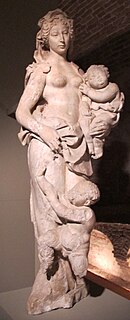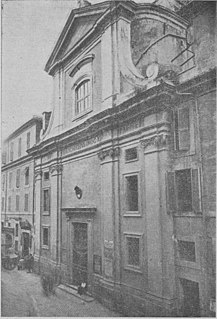Related Research Articles

The Forum Boarium was the cattle forum venalium of ancient Rome. It was located on a level piece of land near the Tiber between the Capitoline, the Palatine and Aventine hills. As the site of the original docks of Rome, the Forum Boarium experienced intense commercial activity.

The Basilica of St. Augustine in Campo Marzio, commonly known as Basilica of St. Augustine and locally as Sant'Agostino, is a Roman Catholic titular minor basilica dedicated to Saint Augustine of Hippo in Rome, Italy. It is the mother church of the Order of Saint Augustine and it is located near the Piazza Navona in the rione Sant'Eustachio.

Antonio Nibby was an Italian archaeologist and topographer.

The Circus of Maxentius is an ancient structure in Rome, Italy; it is part of a complex of buildings erected by emperor Maxentius on the Via Appia between AD 306 and 312. It is situated between the second and third miles of the Via Appia between the basilica and catacombs of San Sebastiano and the imposing late republican tomb of Caecilia Metella, which dominates the hill that rises immediately to the east of the complex. It is part of the Parco Regionale Appia Antica.

Sant'Andrea delle Fratte is a 17th-century basilica church in Rome, Italy, dedicated to St. Andrew. The Cardinal Priest of the Titulus S. Andreae Apostoli de Hortis is Ennio Antonelli.
Bolae or Bola was an ancient city of Latium that was repeatedly mentioned in the early history of Rome. It was likely located in the territory of the modern town of Labico.

Via Asinaria was an ancient Roman road that started from Porta Asinaria in the Aurelian walls (Rome). It was somehow connected with the Via Latina, as it is reported that Belisarius, during its advance on Rome, left the Via Latina to enter the city from Porta Asinaria; the latter was considered one of the main accesses for those coming from the south, as in ancient times the 17th-century Porta San Giovanni didn't exist.

The Mons Sacer, Sacer Mons, or Sacred Mount is a hill in Rome, famed as the location of the first secession of the plebs, in 494 BC.
Politorium was a town in ancient Latium, Italy.

The Church of Saints Martin and Sebastian of the Swiss is a Roman Catholic oratory in Vatican City. The church was built by Pope Pius V in 1568 to serve as a private chapel for the Pontifical Swiss Guards, whose barracks are located next to Porta San Pellegrino, close to the Apostolic Palace. It is considered the national church of Switzerland in Rome.
Longula was a town in ancient times in the territory of the Volsci in central Italy. It was located south of Rome, and just north of the Volscian capital Antium.
Pollusca was a town in ancient times in the territory of the Volsci in central Italy. It was located south of Rome, north of the Volscian capital Antium, and just west of Corioli.

San Bernardino in Panisperna or Panispermia or San Bernardino ai Monti or San Bernardino da Siena ai Monti is a small Roman Catholic church in Rome. It is found across from the church of Sant'Agata dei Goti on via Panisperna in the Rione Monti.

Porta Cavalleggeri was one of the gates of the Leonine Wall in Rome (Italy).

Santa Caterina da Siena is a church in Rome dedicated to Catherine of Siena. It is sited on via Giulia in the Regola district.

The Azienda Ospedaliera San Giovanni Addolorata in Rome (Italy) is one of the largest hospitals in central Italy; the current administrative designation refers to one of the largest and oldest hospitals in the city, commonly designated as San Giovanni hospital.

San Caio was an ancient titular church in Rome, possibly dating from as early as the third century. It was demolished in the late nineteenth century.

Remoria is a place associated with the legendary founding of Rome by Romulus and Remus where, according to Roman tradition, Remus saw six birds land and which he chose as an auspicious location for the future city. It is also where he was buried, after being killed by his brother Romulus during a dispute.

The Villa of Maxentius is an imperial villa in Rome, built by the Roman emperor Maxentius. The complex is located between the second and third miles of the ancient Appian Way, and consists of three main buildings: the palace, the circus of Maxentius and the dynastic mausoleum, designed in an inseparable architectural unit to honor Maxentius.

The church of Santa Galla was a church in Rome (Italy), in the Rione Ripa, on the road that connected Piazza Montanara with Piazza della Bocca della Verità. Both the church and the square in front of it were destroyed between 1928 and 1930 for the construction of the first stretch of Via del Mare ; the furnishings and the altar were relocated to the new church of Santa Galla at Garbatella, built in 1940.
References
- ↑ Dizionario biografico universal, By Gottardo Garollo, 1907, page 750.
- ↑ Itinerario di Roma, e delle sur vicinanze, by Antonio Nibby, page 42.
- ↑ Roma nell'anno 1838, by Antonio Nibby, page 731.